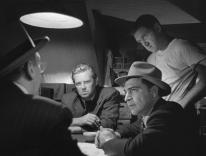Some novelists, playwrights, and filmmakers (Shaw, Voltaire, Jean-Luc Godard) work closer to the vein of the essayist than the storyteller. They may be able to create memorable characters and powerful scenes, but only for the sake of making ideas as tangible as people.
Among current American moviemakers, Todd Haynes is the best example of a storytelling essayist. His strategy is to score his intellectual points by doing riffs on previous, nonintellectual films. His first feature, Poison, spins variations on TV documentaries, B-movie sci-fi, and Jean Genet’s classic Chant d’Amour, all in the service of a meditation on how society isolates and punishes social and sexual deviation. In his most popular effort to date, Far from Paradise, Haynes mimicked the plot and style of old Douglas Sirk movies (such as Imitation of Life) but filled it with the sort of problems Sirk never dared tackle—race relations, homosexuality, women entrapped by domesticity. The counterpointing of 1950s sleekness with late-twentieth-century turbulence proved titillating.
His latest film is an essay about that notorious shapeshifter, Bob Dylan. The film cites a line from Rimbaud: “Je est un autre” (I am an other). Like Rimbaud, Haynes’s Dylan challenges us: look for me but you can’t find me; I can’t be pinned down by your definitions, so I’m not there. Driving this home, Haynes cast six actors to play different facets of the artist’s personality: the tyro under the spell of Woody Guthrie (Marcus Carl Franklin, a black child with a freakishly adult face); the up-and-coming singer who later gets born again after a near-fatal motorcycle accident (Christian Bale); the “betrayer” of the folk movement when he goes electric and rocks out (Cate Blanchett); the troubled family man (Heath Ledger); the introspective poet (Ben Whishaw, with little to do but recite his lines directly to the camera); and the aging Dylan hiding from his public (Richard Gere, so terminally bland that hiding seems unnecessary).
It’s a clever stroke, but Haynes, not content with multiple casting, also gives these incarnations different names. Why? The changing faces perfectly convey Dylan’s chameleon nature, so the changing names seem like overkill. Is Haynes suggesting that the songwriter could change so drastically that he became six different people? But surely Dylan is protean, not schizophrenic. The movie proceeds like that: clever devices get worked to death, and not-so-clever ones come across as gimmicky.
Examples of I’m Not There at its best: At one point, the little boy named Woody (for once the name change is meaningful) is riding the rails with the sort of hobos Guthrie sang about. They menace him for money, making him fall out of the train into a river where a whale materializes and seems about to swallow him. At first, one may think of Jonah, the prophet without honor in his own country (those hoboes turning against their troubadour), but doesn’t that whale look suspiciously like Mostro, the sea monster who ingests Pinocchio, that notorious little liar? Is this a dig at Dylan the self-mythologizer, the put-on artist? The scene is funny and suggestive.
Even better is the sequence in which Dylan, touring England, confronts hostile audiences and a journalist (ably played by Bruce Greenwood) who takes the songwriter’s changeability for fraudulence. Here Haynes riffs on the wonderful D. A. Pennebaker documentary Don’t Look Back, emulating its cinéma vérité photography and nervous editing, and deploying the genius actress Cate Blanchett to portray the frazzled, ornery, vulnerable, and, yes, rather feminine youth on display in the early 1960s. As always, Haynes doesn’t merely imitate old movies but rearranges and tests them, inventing new locales for borrowed dialogue and freely entering into the fears and fantasies of the speakers. He also briefly references Fellini’s 8 1/2 and Richard Lester’s A Hard Day’s Night to suggest the ways that celebrity sometimes ravages the famous.
So far, so good. But when Haynes is forced to invent original dialogue to dramatize Dylan’s domestic woes in the Heath Ledger–Charlotte Gainsborough sequences, he shows what little interest he has in anyone’s personal life, coming up with nothing better than standard biopic language that leaves the actors stranded in banality. And what’s the point of making the troubled husband a movie star instead of a singer? True, at one time Dylan tried for a feature film career, but what exactly does that have to do with his marriage?
The motorcycle accident that may have shifted the course of Dylan’s life is just tossed onto the screen because it’s a well-known event, but Haynes doesn’t wrest any significance from it. As Dylan the evangelizing Christian, Christian Bale proves his casting wasn’t a pun by supplying emotional conviction and a surprisingly strong singing voice, but the conversion is just there. Once again, Haynes fails to make an important personal event interesting.
One can admire the ingenuity of making the older, reclusive Dylan a Billy the Kid (Dylan having once appeared in a Sam Peckinpah movie about the outlaw) hiding from the law and stirred into risking his freedom when Sheriff Pat Garrett (a clever reincarnation of the Bruce Greenwood journalist) uproots an entire town to make way for a railroad. But why is the town pictured as a Halloween theme village? To portray an America that has lost its authenticity? Perhaps, but it makes Bob/Billy’s efforts seem pointless. Haynes’s cleverness gets out of control too often.
Still, moments of insight and of pertinent playfulness make I’m Not There worth seeing. And there is always Cate Blanchett. She’s a chameleon Dylan himself might salute.
Philip Pullman’s trilogy His Dark Materials, of which The Golden Compass is the first part, was intended for a young-adult audience (readers aged twelve to eighteen), precisely the ones beginning to contemplate the universe and their place in it. Pullman, an atheist, wants to egg on such contemplation and seems fiercely opposed to all religious institutions but not necessarily to religious longings or speculation. In his story, the evil Magisterium represents, no doubt, a Catholic Church that rules (in an alternative universe) an England that is part medieval and part modern. Lord Asriel, the father of the little heroine Lyra, is a Faustian scientist battling Magisterium orthodoxy, and Lyra becomes a pawn in the political battle. Paradoxically, these putatively atheistic books are loaded with supernatural beings, of which the most delightful are the shapeshifting “daemons” that embody a person’s soul and function as guardian angels. I’m only halfway through the series but, so far, Materials seems Gnostic rather than atheistic. I can’t help thinking of Kingsley Amis’s reply to someone who asked if Amis was an atheist: “It’s not that I don’t believe in God. It’s more like I hate him.”
And Chris Weitz’s movie adaptation? With the book’s violence softened, its theology rendered vague, if not blank, and the Magisterium looking more like the Evil Empire in Star Wars than the Catholic Church (dark robes, yes, but no dog collars, crucifixes, pope, Mass, Bibles, or prayers), the movie is clearly meant for an audience younger than Pullman’s readership. Will it lead any young viewers to the books? It may drive them there as they hunger for coherent storytelling. Weitz, who showed such tact and creative fidelity when he filmed Nick Hornby’s About a Boy, has really screwed up this job. All the major scenes are left intact, and the narrative might have unfolded lucidly at a running time of 140 minutes, but at 100 minutes the movie feels rushed, constipated, and sterile. Great gobbets of backstory are strewn through the script in all the wrong places. The photography never achieves the Ultima Thule icy voluptuousness that Pullman’s prose evokes. The editing chivvies the action forward, cutting off moments of wonderment. Consequently, the movie never breathes, never lives.
The computer-graphics special effects seem routine, and the film’s daemons come across as cute pets, precisely what Pullman says they are not. The acting? Mostly competent, though Daniel Craig does not give Lord Asriel the requisite Faustian arrogance. Dakota Blue Richards is as spunky and intelligent as Lyra should be, and Eva Green makes the head witch properly magnetic and swashbuckling. If there’s anything pernicious about this movie, it is that it exposes children to yet another example of fractured, noisy storytelling in a world getting noisier and more attention-fracturing by the second.
Please email comments to [email protected] and join the conversation on our Facebook page.
Previous Story
Lost & Found
Next Story
O'Boba the builder


